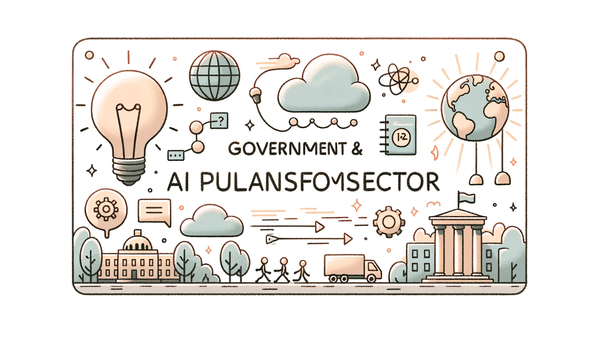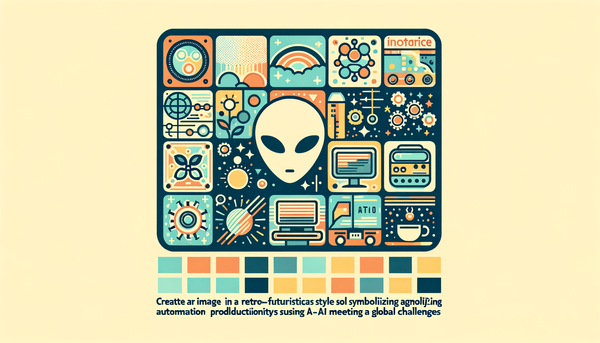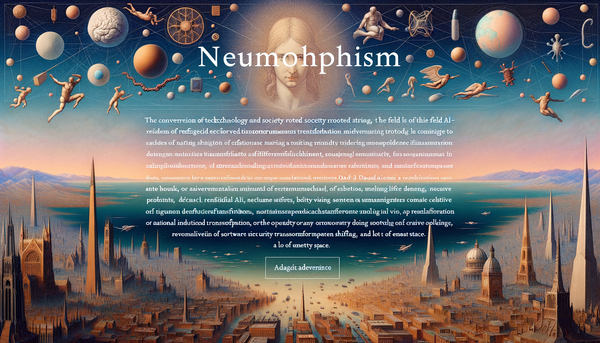The Rise of Augmented Intelligence in Medicine

This article delves into the transformative power of augmented intelligence in medicine—where AI and human expertise unite to revolutionize patient care—while also examining the dramatic shifts in the AI landscape, as illustrated by what some are calling an "AI coup." It explores how the fusion of advanced data analytics and human judgment is reshaping diagnostics, treatment, and medical education, and contrasts that with the abrupt changes in AI organizational dynamics that raise questions of ethics and transparency.
Augmented Intelligence in Medicine: A New Frontier for Healthcare
Medicine has always been a field of precision, empathy, and tireless innovation. In recent years, the infusion of artificial intelligence into this domain has given birth to the concept of augmented intelligence—a potent blend of computer algorithms and human expertise designed to enhance medical decision-making. As detailed in the American Medical Association’s discourse on the subject (read more), this approach is not about replacing doctors, but about empowering them to deliver more personalized and effective care.
Imagine a scenario where a doctor is faced with thousands of electronic health records, intricate medical imaging, and layers of patient history that would normally require hours to sift through manually. Augmented intelligence tools analyze this data in a matter of seconds, identifying patterns and anomalies that might escape the naked eye. This rapid processing not only facilitates early diagnosis, but also tailors treatment plans to the individual needs of patients, thus improving outcomes significantly.
The diagnostic potential is tremendous. For example, in radiology, AI algorithms are now adept at identifying subtle changes in imaging scans—changes that might represent early indications of diseases such as cancer. This kind of technology provides clinicians with a second pair of eyes, ensuring that crucial details are not overlooked.
"Artificial intelligence is not just about automating processes, it’s about transforming industries and making people’s lives better by solving complex problems." – Jack Ma, Founder of Alibaba, 2017
Such technology’s influence extends beyond diagnostics. Augmented intelligence is also revolutionizing medical education. The integration of simulation technology offers medical students a risk-free environment in which to practice complex procedures and surgeries. This hands-on experience, which echoes real-world conditions, ensures that when these students eventually graduate, they are more prepared, confident, and competent to handle live cases.
The symbiotic relationship between technology and human expertise in medicine is a dynamic one. Rather than replacing healthcare professionals, augmented intelligence tools assist them in focusing on the human aspects of patient care—empathy, communication, and critical decision-making in complex cases.
There is also a growing body of research that underscores the benefits of this technology. Studies published in reputable medical journals point out that the integration of AI with traditional medical practice not only streamlines the workflow but also reduces physician burnout, as doctors are relieved of routine data processing tasks. For more in-depth analysis on this intersection of technology and patient care, check out our feature on Transforming Patient Care Efficiency.
Addressing Ethical and Workforce Concerns
Even as augmented intelligence heralds a new era in healthcare, it also brings with it pressing questions regarding ethics, data privacy, and employment. The prospect of AI-driven decision-making in medicine raises concerns about safeguarding patient data and ensuring that these technologies remain tools for enhancement rather than control.
Regulatory bodies are actively working to establish guidelines that ensure the ethical usage of augmented intelligence. These frameworks are designed to protect patient data, ensure transparency in AI algorithms, and prevent misuse. Additionally, there is the issue, frequently debated, of potential job displacement. However, experts argue that augmented intelligence will indeed create new roles, redefining the skill sets required in modern healthcare. Physicians may find more time to concentrate on critical and intricate cases, potentially leading to higher job satisfaction and innovation in the field.
An insightful perspective on this balance was once encapsulated by Michael Dell, who remarked, "We are in the early days of an AI revolution. In the long run, AI will change the very nature of how humans work and interact with machines." While his observation primarily addressed the tech industry at large, its implications for healthcare are equally profound. The idea is not to eliminate the human element but to enhance it—allowing doctors to spend more time building patient relationships rather than being bogged down by administrative duties.
Unpacking the Anatomy of an AI Coup
A parallel narrative that has captivated the AI community revolves around the idea of an AI coup. The Tech Policy Press article (full article here) examines the dramatic realignment within the AI industry, where institutions that once upheld principles of open research and collaboration are experiencing seismic shifts in their operational models.
One prominent example discussed is the transformation of OpenAI from an initially non-profit organization to what many now call a secretive, for-profit entity. This metamorphosis has sparked considerable debate regarding the ethics, transparency, and ultimate goals of AI research. It also raises questions about what such changes mean for the future trajectory of AI development in various sectors, including healthcare.
The term "AI coup" can seem both dramatic and loaded. Yet, when viewed through a historical lens, it mirrors past shifts in technological innovation—from the industrial revolutions that redefined manufacturing to the information revolution that reshaped communication. In this context, the coup is not solely a power grab; it signals an evolution in business strategies and research focuses that are meant to harness AI in more scalable, profitable, and controlled ways.
One might think of this transformation as a double-edged sword. On the one hand, moving towards a for-profit model can accelerate innovation by attracting significant investments and enabling large-scale projects. On the other hand, questions arise about accountability and the potential for monopolistic practices that might hamper open scientific inquiry.
There is an inherent tension between the need for transparency in AI research and the commercial imperatives that drive competition. As companies push to secure intellectual property and maintain market leadership, the delicate balance between proprietary development and communal progress becomes increasingly challenging to maintain.
"The tools and technologies we've developed are really the first few drops of water in the vast ocean of what AI can do." – Fei-Fei Li, The Quest for Artificial Intelligence
This transformation serves as a cautionary tale, highlighting that the democratization of AI advancements must be carefully managed. Policies that encourage ethical AI practices, transparency, and the de-risking of innovations are essential. Responsible governance in the AI space ensures that such power shifts do not compromise the values of openness and collaboration that have historically driven scientific progress.
It is also worth noting that the move towards a more privatized structure in AI research has implications for various industries, including healthcare. As AI becomes more integrated into critical sectors, maintaining ethical oversight is paramount. Whether it’s the deployment of AI in diagnostic tools or the utilization of advanced simulation technology for training future doctors, stakeholders must work together to ensure that ethical guidelines keep pace with technical advancements.
The Convergence and Divergence of AI Trends
Both the advancing use of augmented intelligence in medicine and the upheavals within the AI industry illustrate the broad spectrum of AI's influence across different sectors. While augmented intelligence in healthcare is celebrated for its life-saving benefits and potential to enhance patient outcomes, the internal shifts in the AI industry raise questions about trust, transparency, and corporate governance.
These seemingly disparate narratives converge on a key insight: AI is fundamentally transforming how decisions are made, both inside hospitals and in boardrooms. In medicine, the goal is clear—to improve patient care, enhance medical education, and reduce the burden on healthcare professionals. Here, AI technologies work as trusted partners that boost human decision-making, emphasizing a harmonious blend of empathy and analytics.
Conversely, the narrative of the AI coup underscores the more contentious aspects of technology's evolution—namely, the commercialization and consolidation of power. When organizations that once thrived on openness shift towards secrecy and profit-maximization, it triggers a ripple effect across the industry. This shift challenges traditional norms and prompts the tech community to rethink the frameworks that guide innovation and accountability.
Drawing parallels from history, one may recall the early days of the personal computer revolution when proprietary software models began to emerge. Many industry analysts warned that such changes could stifle innovation, yet they also recognized that a well-regulated commercial environment could drive rapid technological advancements. Similarly, as AI faces its crossroads, stakeholders must balance the dual imperatives of accelerating innovation while ensuring ethical practices.
Consider the experience of healthcare professionals integrating augmented intelligence into their daily practice. Initially, there might be skepticism and resistance to new tools that seem to encroach on traditional methods. However, history has shown that innovation, when harnessed correctly, usually results in greater efficiency and better outcomes. In this light, augmented intelligence in medicine is a powerful example of how advanced systems can complement human expertise while reducing routine administrative burdens.
Moreover, the transformation taking place in parts of the AI industry acts as a reminder of the dynamic and sometimes unpredictable nature of technological progress. Just as augmented intelligence promises to reshape healthcare through more accurate diagnoses and personalized care plans, the internal reconfigurations within high-profile AI organizations suggest significant shifts in how research is conducted, funded, and regulated in the future.
"We are in the early days of an AI revolution. In the long run, AI will change the very nature of how humans work and interact with machines." – Michael Dell, Founder of Dell Technologies, 2004
In both cases, the underlying theme is a call for adaptability and foresight. As we integrate these technologies into everyday operations, whether in a hospital or a tech company, it becomes essential to prepare for a future where the pace of change is rapid and its implications wide-reaching.
Opportunities and Challenges: The Road Ahead
The road ahead for AI is fraught with both tremendous opportunities and complex challenges. On one side, augmented intelligence promises to refine and revolutionize healthcare by leveraging the best of machine efficiency and human empathy. Hospitals are beginning to implement systems that can help diagnose diseases faster by analyzing patterns in patient data that would be nearly impossible to process manually. In addition, these systems are instrumental for medical training, providing immersive and risk-free environments for future practitioners.
On the flip side, the contentious realignment in the AI research ecosystem—as seen in the controversial shifts within established organizations—signals that as AI’s economic and social impact increases, so too does the need for robust governance frameworks. The tension between fostering innovation and maintaining ethical integrity is a recurring theme in the evolution of any transformational technology.
One of the more promising approaches to this balancing act is the establishment of collaborative platforms involving public institutions, private enterprises, and regulatory bodies. Such partnerships are already being conceived in various regions around the world to ensure that as AI technologies continue to permeate critical sectors like healthcare, their deployment is both fair and transparent.
The healthcare sector, as one of the main beneficiaries of augmented intelligence, serves as a striking example of how public-private cooperation can lead to life-changing innovations. For instance, hospitals that have integrated AI-driven tools not only experience improved diagnostic accuracy but also benefit from reduced waiting times for patients and enhanced overall operational efficiency. These outcomes, in turn, foster greater patient trust and higher quality of care.
However, these advancements do come with important caveats. For example, issues of data integrity and security loom large in any discussion that involves vast repositories of sensitive patient information. It is imperative that such systems incorporate state-of-the-art cybersecurity measures while adhering to strict regulatory standards, ensuring that technology enhances rather than jeopardizes healthcare outcomes.
In the broader context of the AI industry, debates over the shift from non-profit collaborations to more commercially driven models continue to intensify. Critics argue that greater commercialization risks sidelining fundamental research in favor of immediately profitable applications. Advocates, on the other hand, believe that such structural changes attract investment and spur rapid innovation. The truth, perhaps, lies somewhere in between, demanding a measured approach where significant investments in research are balanced with an unswerving commitment to ethical practices.
It is inspiring to observe that despite these challenges, the pursuit of excellence remains a constant theme among innovators. Researchers and practitioners are not only pushing the boundaries of what technology can do—whether in a clinical setting or within corporate boardrooms—but are also increasingly mindful of the ethical and social responsibilities that come with such power.
Examples of Real-World Applications
To illustrate the transformative potential of augmented intelligence in medicine, consider the following real-world scenarios:
- Medical Imaging Diagnostics: Radiologists now employ AI algorithms that can analyze X-rays, MRIs, and CT scans in real time, flagging anomalies that might indicate early-stage diseases. Such tools serve as an invaluable second opinion, increasing diagnostic accuracy and enabling earlier intervention.
- Personalized Treatment Plans: By processing large datasets from patient records, AI can suggest personalized treatment plans tailored to the unique genetic and physiological profiles of individual patients, thereby maximizing the effectiveness of therapies.
- Simulation-Based Medical Education: Augmented intelligence integrated with virtual reality allows medical students to simulate complex surgical procedures, gain hands-on experience, and build critical decision-making skills before ever stepping into an operating room.
- Predictive Analytics in Patient Monitoring: In intensive care units, AI-powered systems monitor patient vitals continuously, alerting medical staff to potentially life-threatening changes well before traditional monitoring methods would detect them.
In parallel, consider the broader implications of the shifts in the AI industry. The transition of prominent organizations into profit-driven models—a trend some label as the "anatomy of an AI coup"—serves as a wake-up call for policymakers, researchers, and technologists. It underscores the need for continued vigilance and a proactive approach in ensuring that the immense power of AI is wielded responsibly.
In reflecting on these trends, it's useful to observe that both the technological advancements in medicine and the structural adjustments within the AI industry are two sides of the same coin. They represent the relentless march of progress—a progress that, while exhilarating, demands careful consideration of its societal and ethical implications.
Bridging the Gap: Collaborative Efforts and the Future of AI
Looking ahead, one recurring theme in both discussions—the integration of AI in medicine and the broader structural shifts in the AI arena—is the need for collaboration. The future of augmented intelligence in healthcare hinges on the effective partnership between technological innovators, healthcare providers, and regulatory authorities. Similarly, the ethos of transparency and shared progress in the AI research community can only be reinforced through cooperative engagements between academia, industry, and government bodies.
Innovative projects that bring together multidisciplinary teams are already taking shape. For example, leading hospitals are partnering with tech startups to develop AI-driven tools that not only improve patient outcomes but also streamline operational workflows. These collaborations often involve close cooperation with regulatory bodies that help align technological advancements with rigorous standards of patient safety and data privacy.
The need for such collaborative frameworks is more pressing than ever in an era defined by rapid technological change. As advanced technologies like augmented intelligence become more integrated into everyday life, stakeholders across all sectors must come together to ensure that these tools serve the collective good.
One promising initiative includes the push for open-source AI projects that enable researchers from around the world to contribute, critique, and improve upon the technology. Such initiatives reinforce the value of community-driven progress and facilitate a culture where innovation is not stifled by closed corporate silos.
Indeed, the challenges associated with the commercialization of AI research—as examined in discussions of the "AI coup"—can be mitigated by fostering an environment of shared knowledge and mutual accountability. By learning from the successes in sectors like healthcare, where augmented intelligence is implemented to enhance lives, the broader AI industry can strive for a future that blends prosperity with ethical stewardship.
Further Readings and Insights
For readers interested in a deeper exploration of these topics, here are some valuable resources:
- American Medical Association on Augmented Intelligence in Medicine – A detailed look at how AI is supporting healthcare professionals in diagnostics and treatment.
- Tech Policy Press on the Anatomy of an AI Coup – An analytical examination of recent shifts in the AI industry's structure and their broader implications.
- Revolutionizing Medicine with Augmented Intelligence – An AI.Biz feature that delves into cutting-edge practices in medical AI.
- AI in Healthcare Transforming Patient Care Efficiency – A discussion on how technological integrations are reshaping patient services.
These readings not only provide further context but also offer diverse perspectives on the exciting developments at the intersection of technology, ethics, and human wellbeing.
Conclusion: A Dual Perspective on the AI Revolution
In reflecting upon the transformative impact of augmented intelligence in medicine alongside the controversial shifting dynamics within the AI industry, it becomes evident that the current era is one of profound change. On one end, the medical field is experiencing a renaissance where technological tools empower healthcare professionals to deliver better, faster, and more personalized care. On the other end, the internal evolution of AI organizations—marked by transitions that some have dubbed an "AI coup"—raises important questions about the future of research, ethics, and transparency in technology.
Together, these narratives form a comprehensive picture of an industry in flux: one where the integration of AI offers unprecedented opportunities to improve lives and drive innovation, yet requires a careful balancing act between profit, privacy, and public trust. The future will likely see further integration, collaboration, and, inevitably, new challenges. Our duty as a society is to harness these innovations responsibly while ensuring that the imperative for ethical conduct remains front and center.
This is but a snapshot of an ongoing revolution in AI, one where every advancement is a reminder of the limitless potential of human ingenuity coupled with machine precision. As we look forward, the journey will undoubtedly be complex, but it is one that promises to redefine the boundaries of what is possible in medicine, technology, and beyond.




